More than 46 million homes in the U.S. proudly include a cat as a family member. However, for allergy sufferers, the dream of feline companionship can often be overshadowed by sneezes, sniffles, and itchy eyes. If you’re among those who adore cats but dread the allergic reactions, you’ve likely wondered: Are There Hypoallergenic Cats? The answer isn’t a simple yes or no, but rather a nuanced exploration into breeds that might allow you to live more comfortably with a feline friend.
Understanding Hypoallergenic Cats: Debunking the Myth
Before diving into specific breeds, it’s crucial to understand what “hypoallergenic” truly means in the context of cats. Despite the common term, no cat breed is entirely hypoallergenic. All cats produce allergens, proteins that trigger allergic reactions in sensitive individuals. These allergens, primarily the Fel d 1 protein, are found in cat dander (dead skin cells), saliva, and urine.
So, why are some cats labeled as hypoallergenic? The term is used to describe certain breeds that produce fewer allergens or shed less dander compared to others. This reduction in allergen load can make them more tolerable for people with mild to moderate cat allergies. It’s about minimizing exposure, not eliminating allergens entirely.
12 Cat Breeds Often Considered Hypoallergenic
While individual reactions can vary, certain cat breeds are frequently recommended for allergy sufferers. Remember, spending time with a specific cat breed before bringing them home is always advisable to gauge your personal allergic response.
1. Siberian
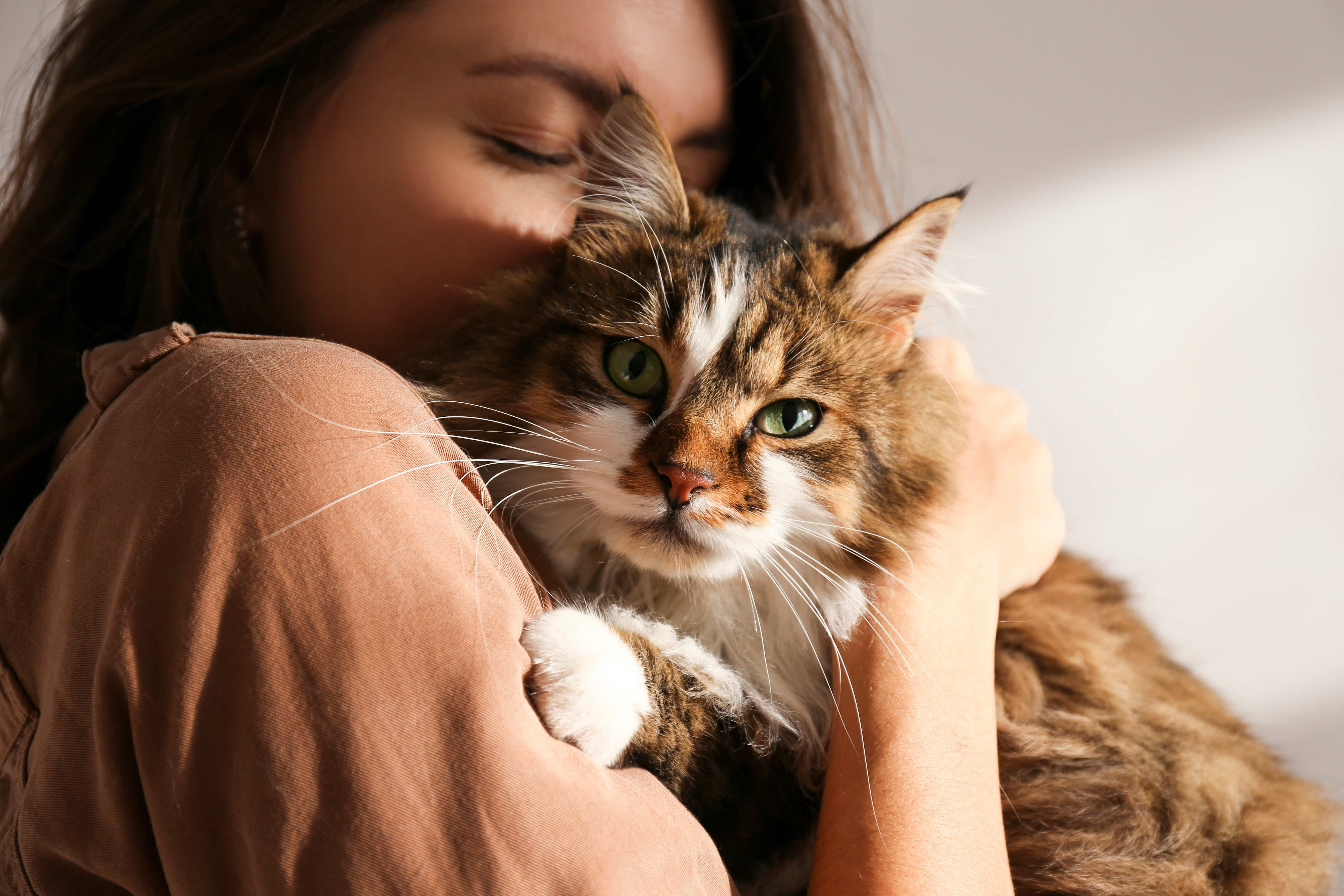 woman snuggling a longhair brown and white siberian cat
woman snuggling a longhair brown and white siberian cat
Alt text: A woman affectionately snuggles a brown and white Siberian cat with long fur, highlighting the breed’s hypoallergenic nature despite its coat length.
Siberians are a surprising entry on the hypoallergenic list due to their luxurious, long coat. Despite their thick fur, they produce less Fel d 1 protein in their saliva than many other breeds. This lower protein level translates to fewer allergens spread through grooming and dander. Beyond their allergy-friendliness, Siberians are known for their gentle, playful, and affectionate nature, making them wonderful family pets. However, their long coat does require regular grooming to prevent mats and tangles.
2. Siamese
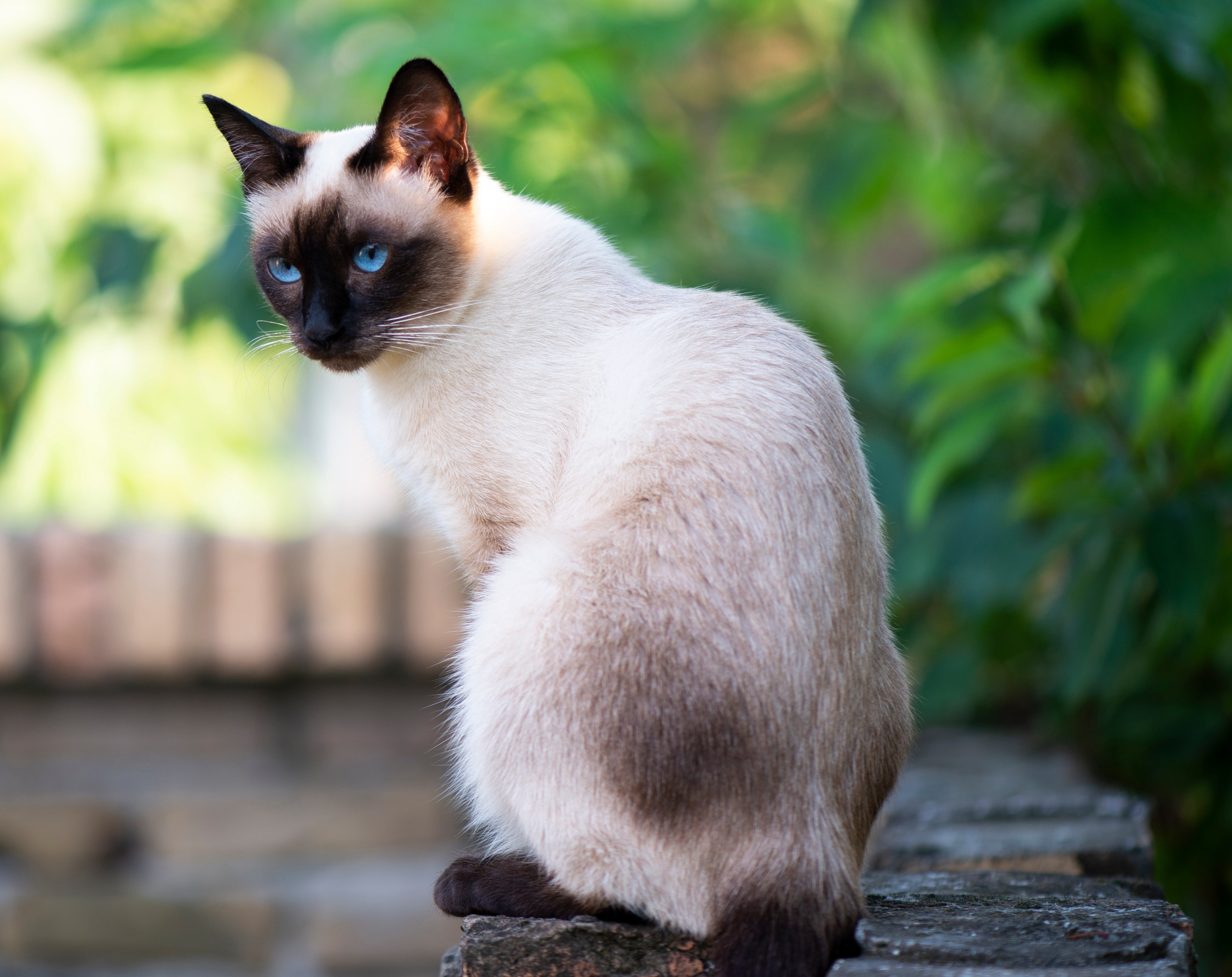 siamese cat sitting outside
siamese cat sitting outside
Alt text: Elegant Siamese cat with blue eyes sitting outdoors, showcasing its short coat known for producing fewer allergens.
The striking Siamese cat, with its distinctive pointed coloration and sapphire blue eyes, is another breed often cited as hypoallergenic. Their short, fine coat sheds less than many other breeds, which contributes to a lower dispersal of dander and allergens around the home. Siamese cats are renowned for their intelligence, vocalizations, and strong bonds with their owners. They are active and demand attention, thriving in households where they receive plenty of interaction. Their short coat is relatively low-maintenance in terms of grooming.
3. Bengal
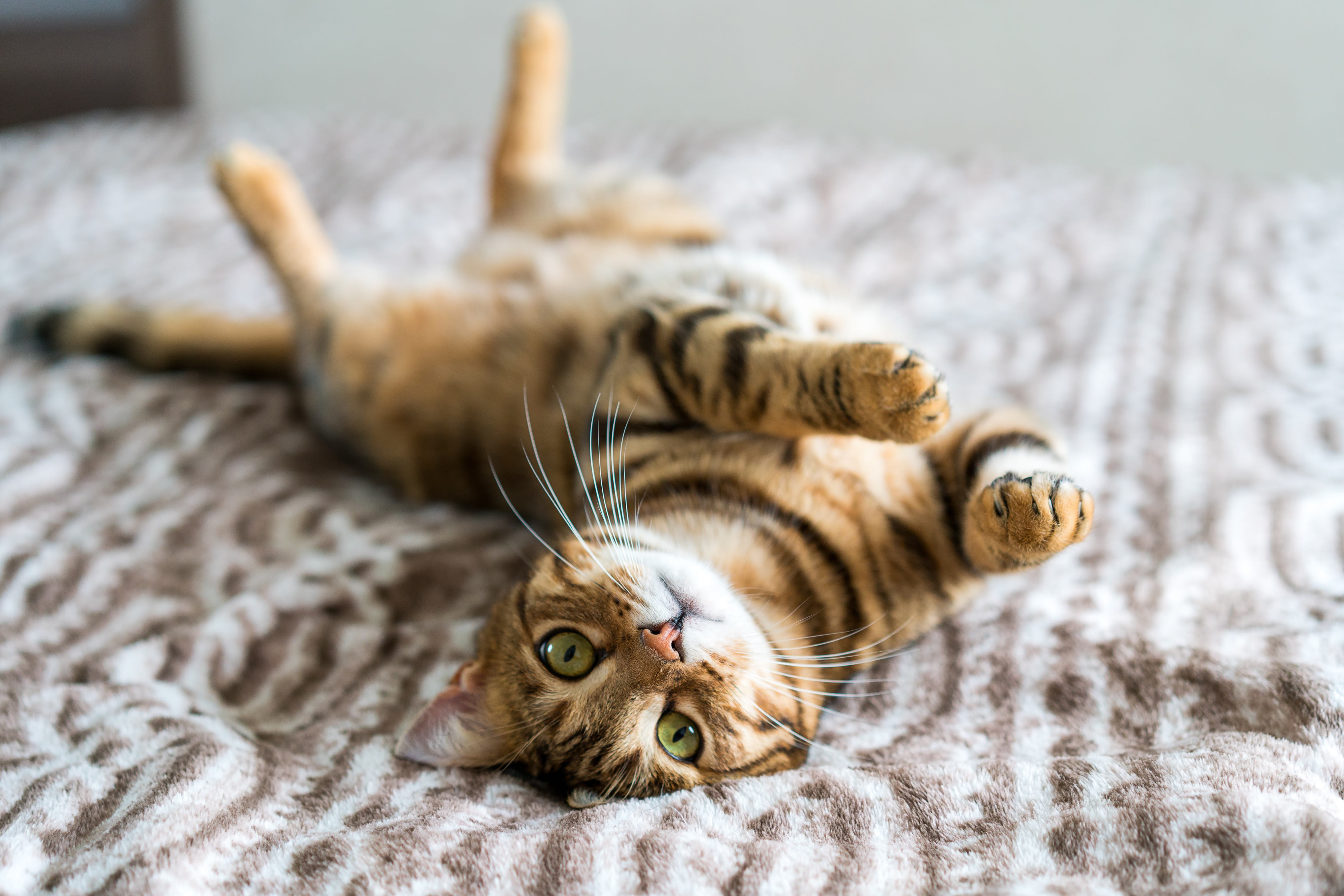 bengal cat lying on a bed on his back and showing his stomach
bengal cat lying on a bed on his back and showing his stomach
Alt text: Bengal cat with spotted coat lying on its back, emphasizing the breed’s short, leopard-like fur and hypoallergenic qualities.
Bengal cats, with their wild appearance reminiscent of their Asian Leopard Cat ancestry, are a visually stunning and often hypoallergenic breed. Their short, dense coat sheds minimally, reducing the spread of allergens. Bengals are highly energetic, intelligent, and playful cats that require a stimulating environment. They are known for their adventurous spirit and can be quite vocal. Their grooming needs are minimal due to their short coat, but their high energy levels require dedicated playtime and interaction.
4. Russian Blue
 russian blue cat headbutting a man
russian blue cat headbutting a man
Alt text: Affectionate Russian Blue cat gently headbutting a man, highlighting the breed’s gentle nature and hypoallergenic coat.
Russian Blue cats are prized for their plush, silvery-blue coat and gentle temperament, and they are also considered a hypoallergenic breed. They have a dense, short coat that sheds less than many other breeds, and they are believed to produce less Fel d 1 protein. Russian Blues are known for their calm and quiet demeanor, making them excellent companions for those seeking a more serene feline friend. They can be initially shy with strangers but are deeply devoted to their families. Their grooming needs are relatively low, requiring only occasional brushing.
5. Sphynx
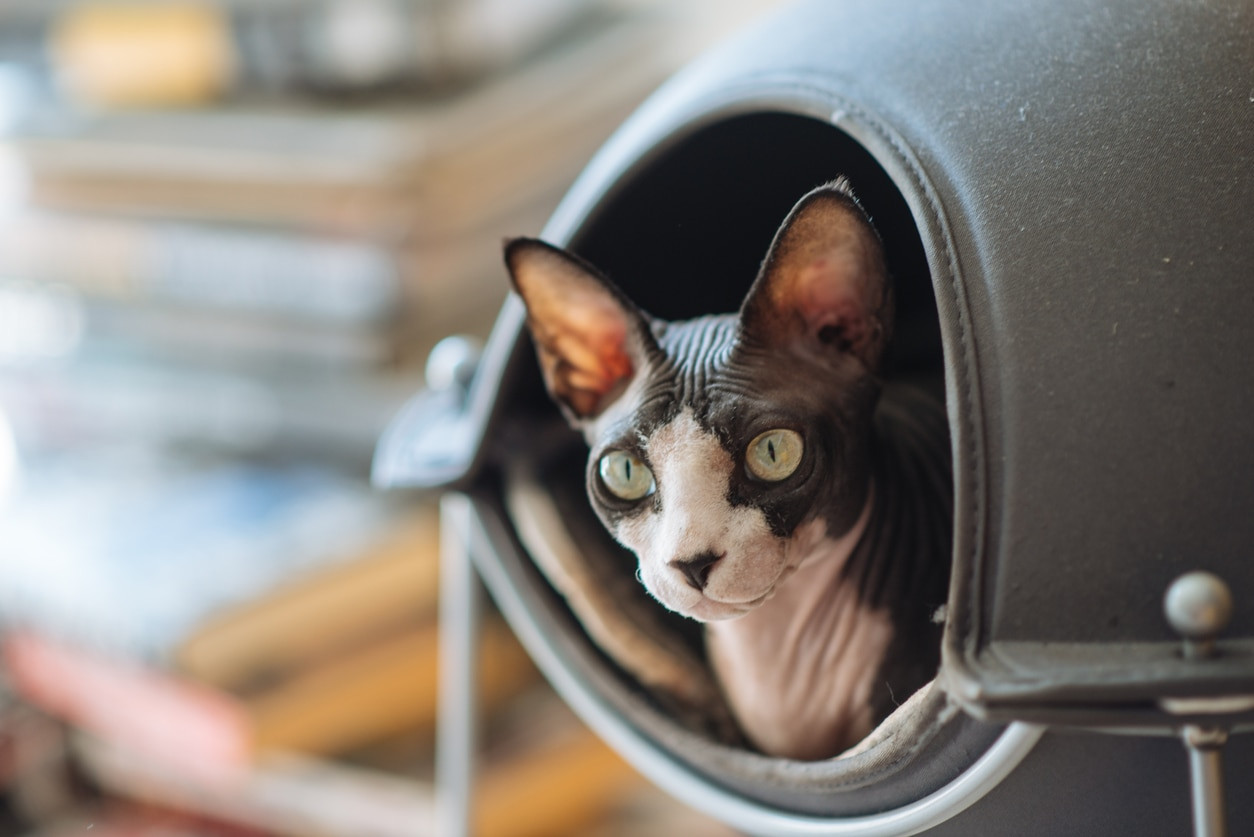 black and pink sphynx cat looking out of a covered cat bed
black and pink sphynx cat looking out of a covered cat bed
Alt text: Hairless Sphynx cat with black and pink skin peering out of a cat bed, emphasizing its unique appearance and hypoallergenic nature due to lack of fur.
The Sphynx cat is perhaps the most recognizable hypoallergenic breed due to its lack of fur. While not entirely hairless (they have a fine down), their minimal coat significantly reduces shedding and dander. However, it’s important to note that Sphynx cats still produce allergens in their saliva and skin oils. Sphynx cats are known for their outgoing, affectionate, and attention-seeking personalities. They are often described as dog-like in their devotion and playfulness. Despite lacking fur, Sphynx cats require regular bathing to remove oil buildup on their skin.
6. Devon Rex
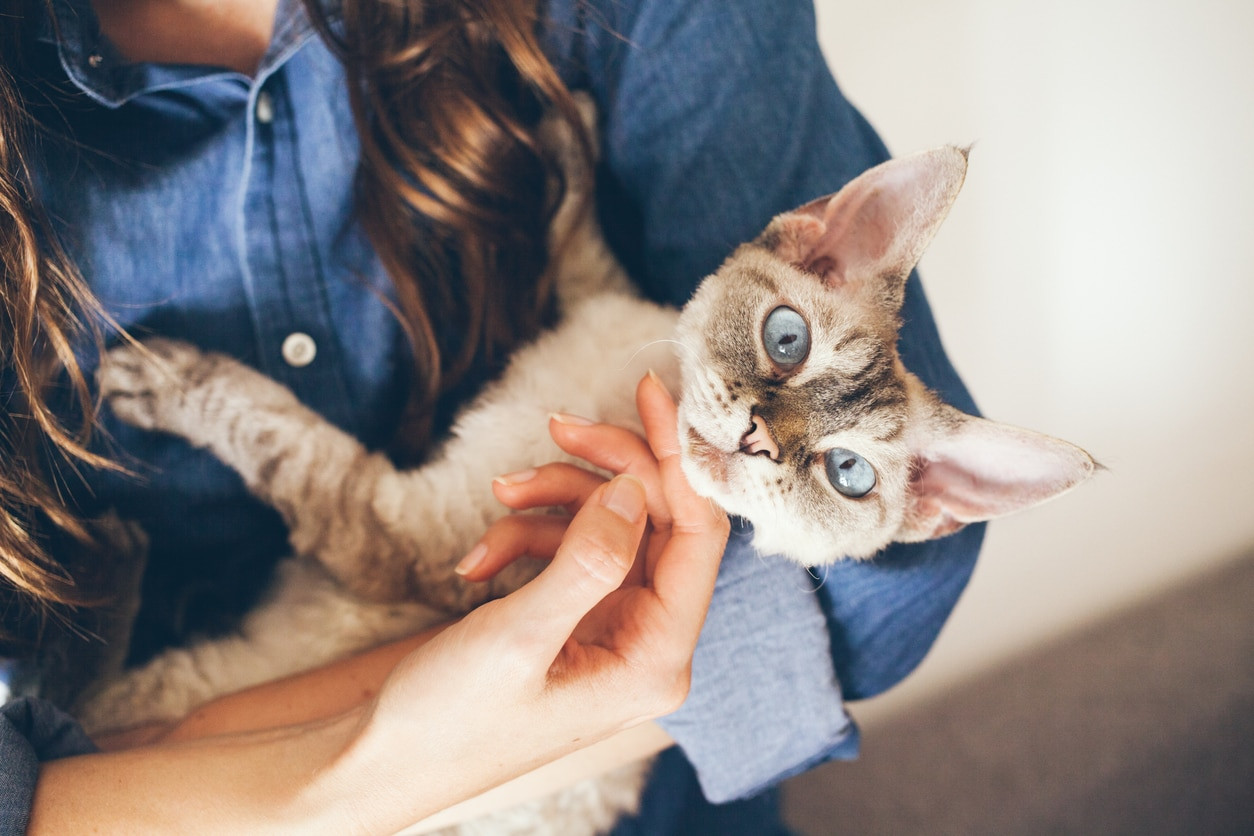 woman holding a devon rex cat like a baby
woman holding a devon rex cat like a baby
Alt text: Woman cradling a Devon Rex cat with curly fur like a baby, showcasing the breed’s affectionate nature and hypoallergenic coat.
Devon Rex cats are characterized by their large ears, elfin faces, and soft, wavy coat. This unique coat sheds very little, making them a good choice for allergy sufferers. Like the Cornish Rex, their coat is close-lying and lacks guard hairs, resulting in less dander. Devon Rex cats are intelligent, playful, and highly social. They are known for their mischievous nature and love to be involved in household activities. Their grooming needs are minimal due to their short, curly coat.
7. Cornish Rex
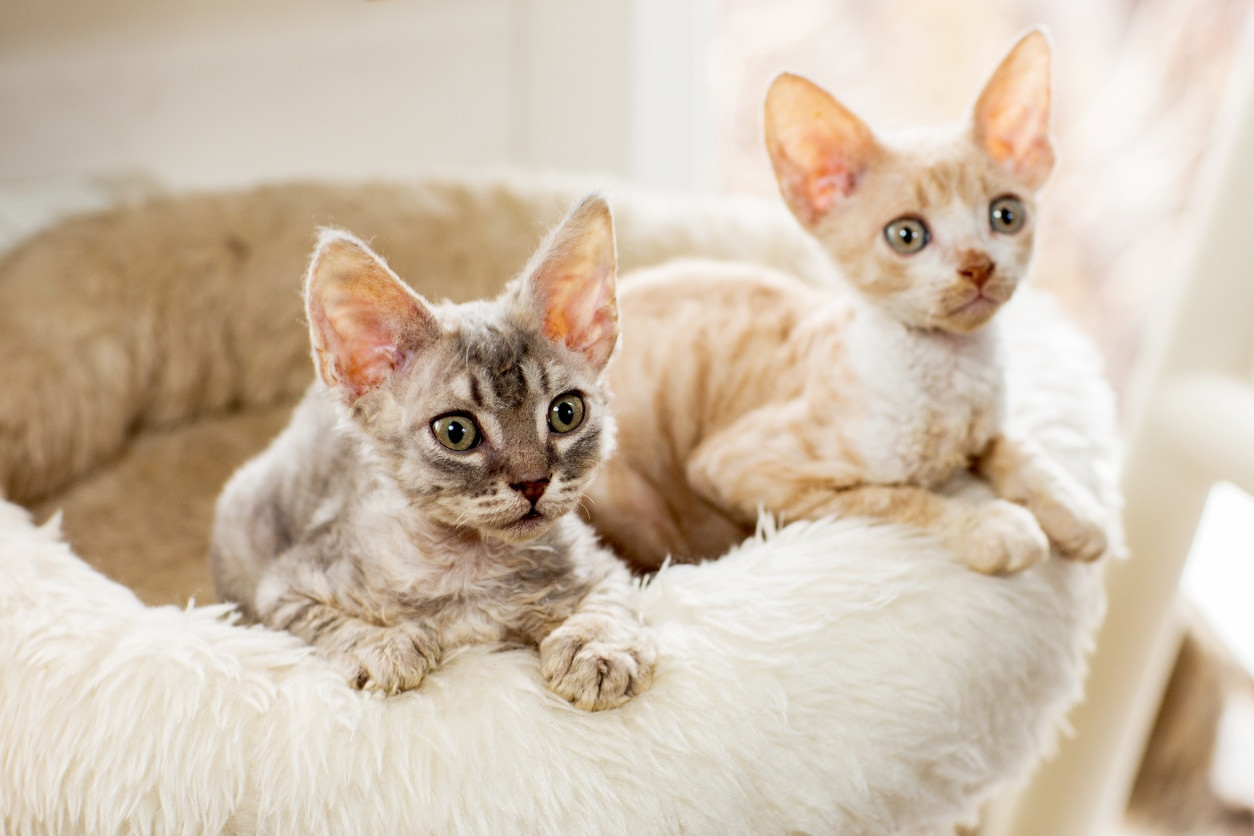 two cornish rex kittens in a cat bed
two cornish rex kittens in a cat bed
Alt text: Two Cornish Rex kittens with wavy coats nestled in a cat bed, highlighting the breed’s soft, curly fur and hypoallergenic qualities.
Cornish Rex cats share the Devon Rex’s curly coat but have a different genetic mutation responsible for their unique fur. Their coat is also very short, fine, and wavy, lying close to the body and shedding minimally. This lack of heavy shedding contributes to their hypoallergenic reputation. Cornish Rex cats are active, playful, and affectionate, known for their kitten-like energy throughout their lives. They are social cats who enjoy human companionship and interaction. Their short coat requires minimal grooming.
8. Javanese
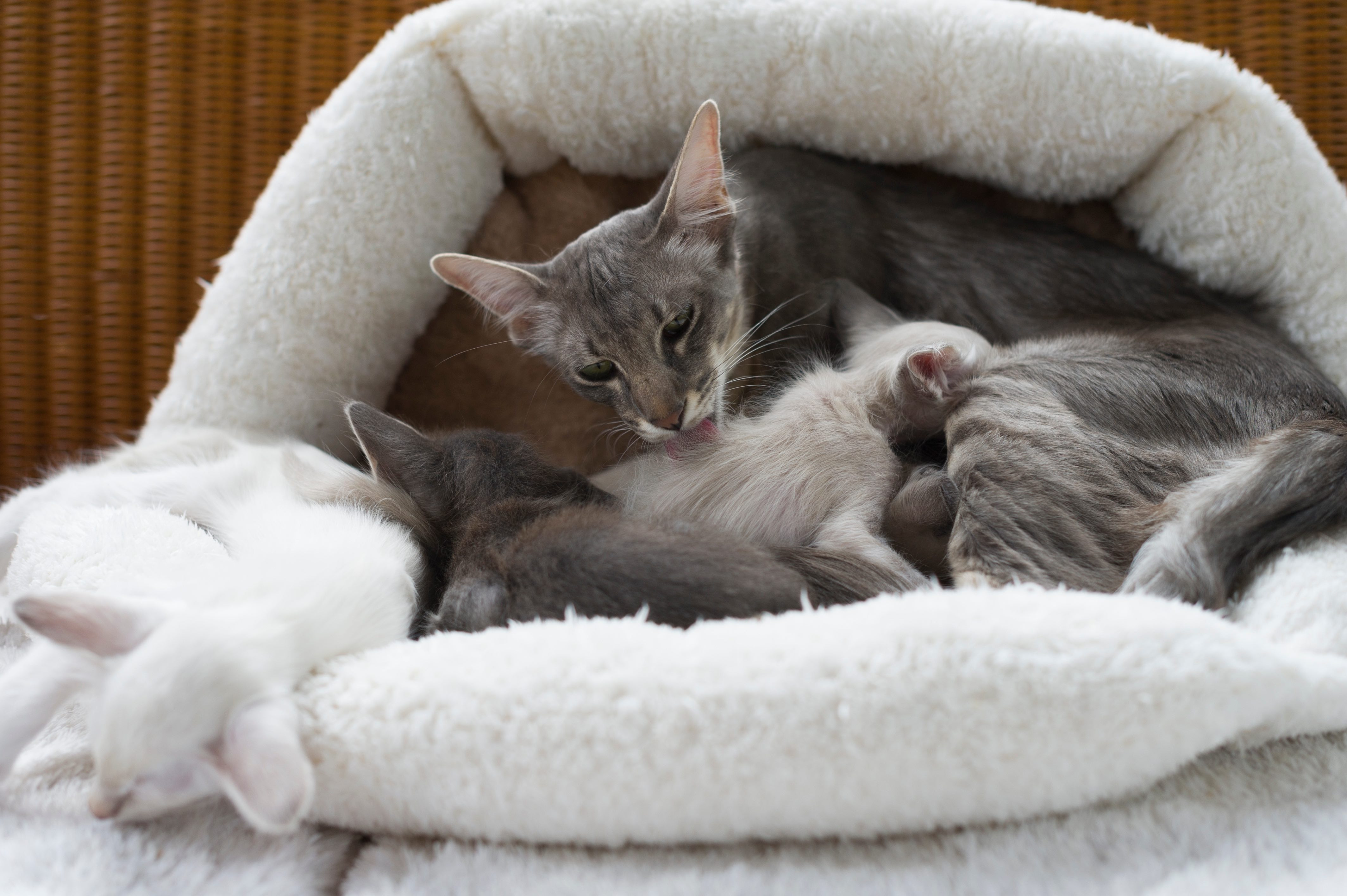 gray javanese cat mom grooming her kittens
gray javanese cat mom grooming her kittens
Alt text: Javanese cat mother with a gray coat grooming her kittens, illustrating the breed’s longer, silky fur that is still considered hypoallergenic.
Javanese cats, closely related to Siamese and Balinese breeds, possess a silky, medium-length single coat. Despite their longer fur, they produce less Fel d 1 protein, making them considered hypoallergenic. Their single coat also means they lack an undercoat, resulting in less shedding. Javanese cats are intelligent, vocal, and people-oriented. They are known for their playful and curious nature, forming strong bonds with their families. While their coat is longer, it is relatively low-maintenance, requiring regular brushing to prevent tangles.
9. Balinese
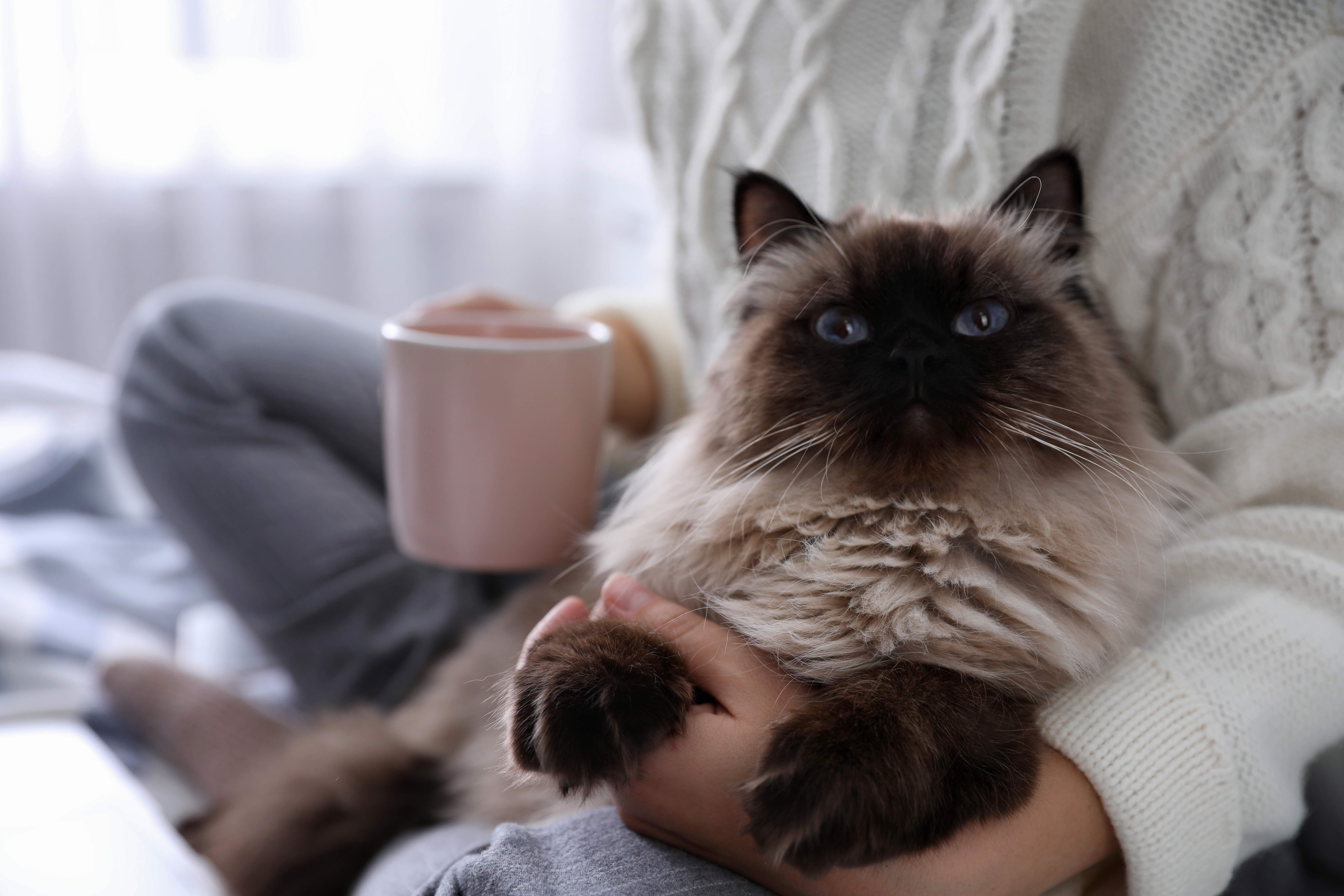 longhaired balinese cat snuggling with a woman
longhaired balinese cat snuggling with a woman
Alt text: Longhaired Balinese cat with pointed coloration snuggling with a woman, showcasing the breed’s elegant appearance and hypoallergenic traits.
The Balinese is essentially a longhaired Siamese, sharing the same pointed coloration and elegant appearance. Like Siamese and Javanese cats, Balinese cats produce less Fel d 1 protein, contributing to their hypoallergenic status. Their single, silky coat is surprisingly low-shedding for a longhaired breed. Balinese cats are intelligent, affectionate, and vocal, inheriting the Siamese’s people-loving nature. They are playful and enjoy interactive toys and activities. Despite their longer coat, they are relatively easy to groom, requiring regular brushing to prevent mats.
10. Oriental Shorthair
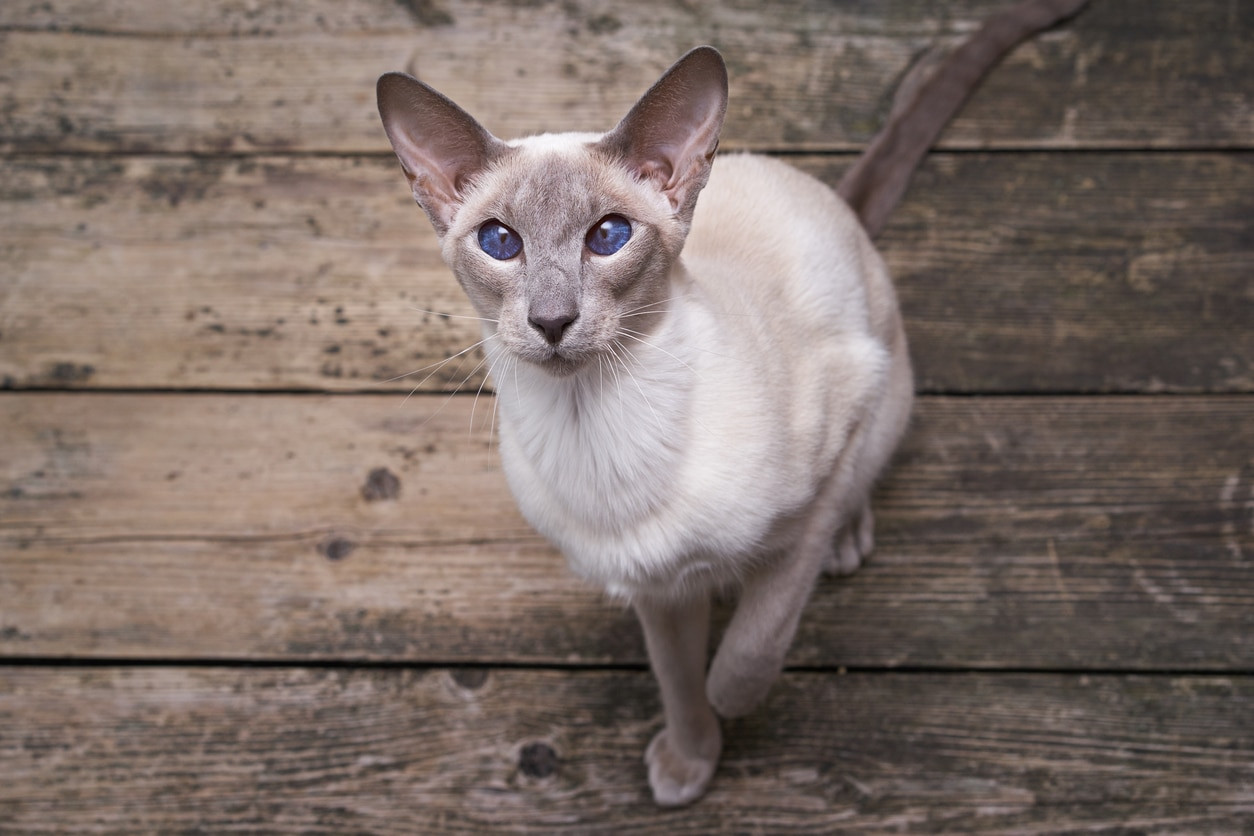 gray and white oriental shorthair cat looking up at the camera
gray and white oriental shorthair cat looking up at the camera
Alt text: Alert Oriental Shorthair cat with gray and white markings looking at the camera, highlighting its sleek, short coat and hypoallergenic qualities.
Oriental Shorthair cats are known for their striking, slender bodies and large, expressive ears. Their short, fine coat sheds minimally and requires very little grooming, making them a good choice for allergy sufferers. Oriental Shorthairs are highly intelligent, curious, and playful cats. They are social and thrive on human interaction, often forming strong bonds with their families. They are active and enjoy exploring their surroundings, needing plenty of mental and physical stimulation.
11. Burmese
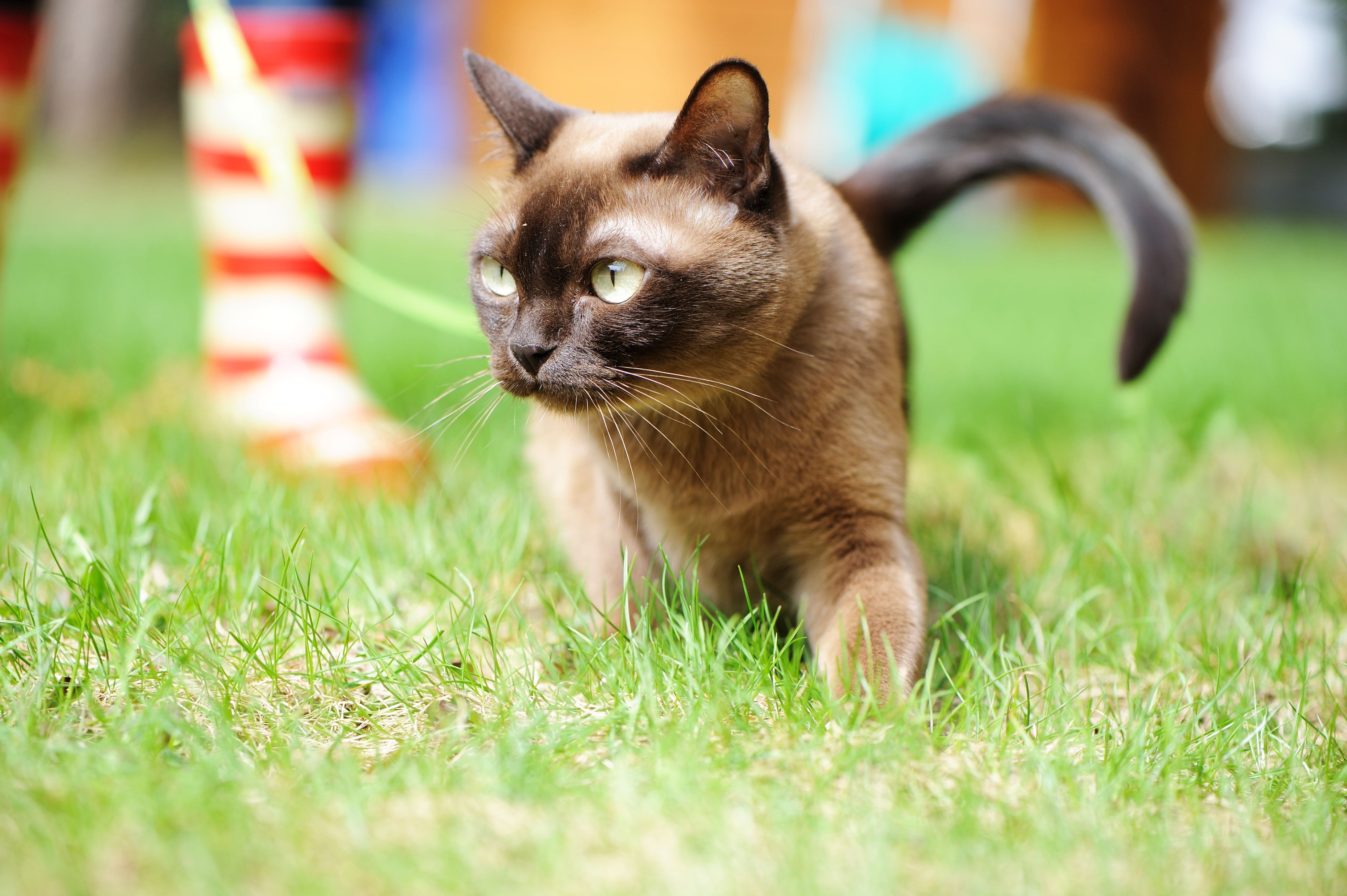 burmese cat walking on a leash and harness outside
burmese cat walking on a leash and harness outside
Alt text: Burmese cat with a short, dark coat walking on a leash and harness, emphasizing the breed’s low-shedding fur and suitability for allergy sufferers.
Burmese cats possess a sleek, satin-like short coat that sheds very little and requires minimal grooming. This low-shedding quality contributes to their hypoallergenic reputation. Burmese cats are known for their affectionate, playful, and people-oriented personalities. They are intelligent and enjoy interactive play, often maintaining a kitten-like energy throughout their lives. They are social cats who thrive on companionship and can be quite vocal.
12. Tonkinese
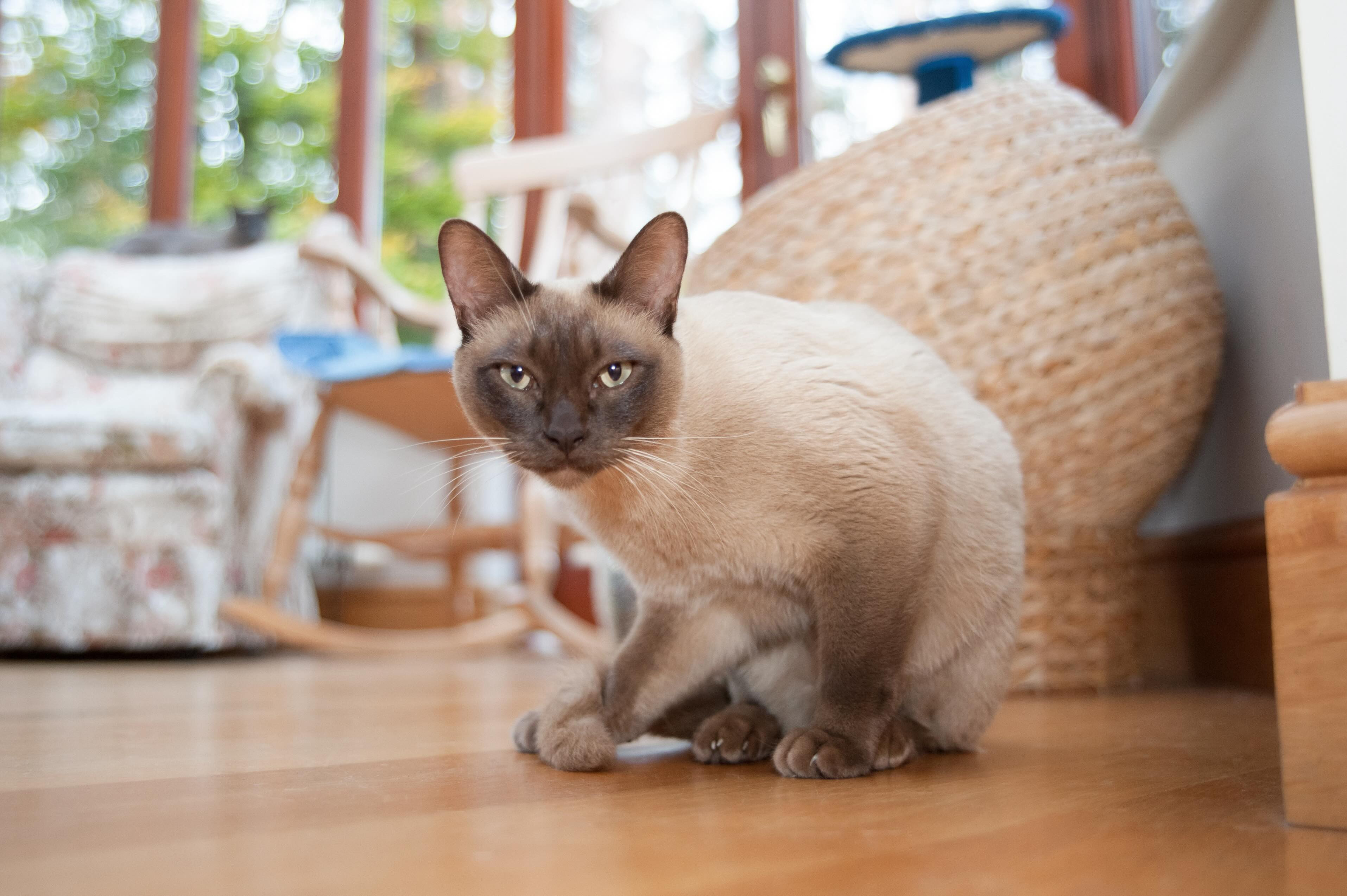 champagne tonkinese cat sitting on the floor and looking straight at the camera
champagne tonkinese cat sitting on the floor and looking straight at the camera
Alt text: Champagne Tonkinese cat with short fur sitting and looking directly at the camera, showcasing the breed’s hypoallergenic coat and engaging gaze.
Tonkinese cats are a hybrid breed resulting from crossing Siamese and Burmese cats. They inherit the desirable traits of both parent breeds, including a short, silky coat that sheds minimally and is considered hypoallergenic. Tonkinese cats are known for their playful, affectionate, and intelligent nature. They are social and enjoy being around people, often described as having a dog-like devotion to their families. They are also quite vocal and enjoy “conversing” with their owners.
Tips for Minimizing Allergens When Adopting a Cat
Choosing a potentially hypoallergenic breed is just one piece of the puzzle. Here are additional strategies to further reduce allergen exposure in your home:
Thorough Research and In-Person Interaction
Before committing to any cat, especially if allergies are a concern, research different hypoallergenic breeds and visit breeders or shelters. Spending time with the specific breed and ideally the individual cat you’re considering adopting is crucial. This firsthand experience will help you gauge your allergic reaction in a controlled environment.
Consult an Allergy Specialist
If you have known cat allergies, consulting an allergist is a wise step before bringing a cat into your home. They can perform allergy testing to confirm your sensitivity and recommend strategies for managing your allergies, including medication or immunotherapy.
Maintain a Clean Home Environment
Regular cleaning is paramount in minimizing allergens. Vacuum frequently with a HEPA filter vacuum cleaner, focusing on carpets, rugs, and upholstery. Dust regularly with a damp cloth to trap allergens instead of dispersing them into the air. Wash bedding, including pet bedding, frequently in hot water.
Consider Air Purifiers
HEPA air purifiers can significantly reduce airborne allergens, including cat dander. Place air purifiers in key areas of your home, especially bedrooms and living rooms, to create cleaner air spaces.
Discuss Allergen-Reducing Cat Food with Your Vet
Innovative cat food options, such as Purina Pro Plan LIVECLEAR, are formulated to reduce the active Fel d 1 allergen in cat saliva. This dietary approach can be a valuable tool in managing cat allergies. Consult your veterinarian to determine if this type of food is suitable for your cat and your allergy management plan.
FAQs About Cats and Allergies
Are there truly non-shedding cats?
While breeds like the Sphynx are often referred to as non-shedding, it’s more accurate to say they shed minimally. They still produce dander and skin oils, which contain allergens. No cat is entirely non-shedding in the truest sense.
Can a cat be 100% hypoallergenic?
No, despite the term “hypoallergenic,” no cat breed is 100% allergen-free. All cats produce allergens to varying degrees. Hypoallergenic breeds are simply those that produce fewer allergens or shed less dander, potentially making them more tolerable for allergy sufferers.
WRITTEN BY: Solcat Content Team

